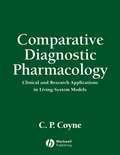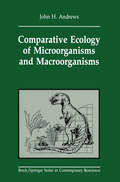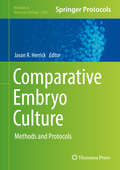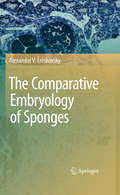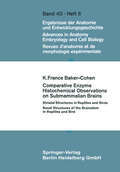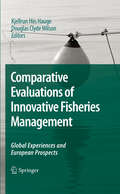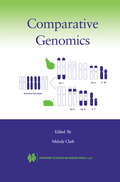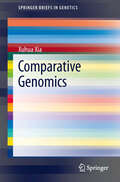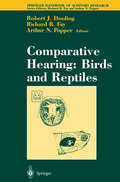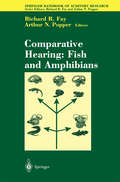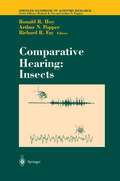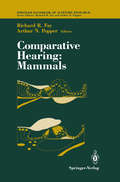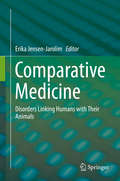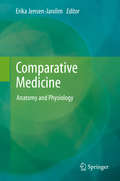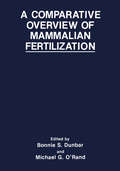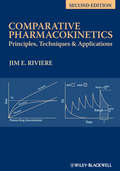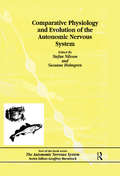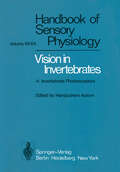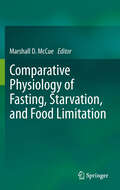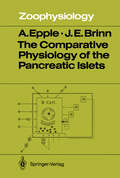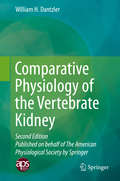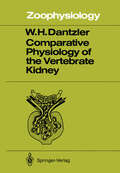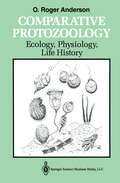- Table View
- List View
Comparative Diagnostic Pharmacology: Clinical and Research Applications in Living-System Models
by C.P. CoyneComparative Diagnostic Pharmacology: Clinical and Research Applications in Living-System Models is the first evidence-based reference text devoted exclusively to the subject of applying pharmaceutical and biopharmaceutical agents as diagnostic probes in clinical medicine and investigative research.This unique and groundbreaking book is a versatile guide for clinicians and researchers interested in using pharmacologic agents to: Diagnose disease Assess physiological processes Identify the appropriateness of a therapeutic agent Determine appropriate dosing for therapeutic use. Extensively referenced and organized by major body systems, individual topics are listed in an evidence-based format according to specific disease processes or physiological processes of interest. Each entry also includes information on the mechanism of action, administration, and diagnostic interpretation. Descriptions have been provided for the application of diagnostic pharmaceuticals to assess a wide spectrum of diseases and physiological processes relevant to the fields of veterinary and human medicine. Comparative Diagnostic Pharmacology is useful not merely for pharmaceutical-oriented research investigations, but it will also prove invaluable for the monitoring and evaluation of physiological responses and disease processes in animal models.
Comparative Ecology of Microorganisms and Macroorganisms (Brock Springer Series in Contemporary Bioscience)
by John H. AndrewsThe most important feature of the modern synthetic theory of evolution is its foundation upon a great variety of biological disciplines. -G. L. STEBBINS, 1968, p. 17 This book is written with the goal of presenting ecologically significant anal ogies between the biology of microorganisms and macroorganisms. I consider such parallels to be important for two reasons. First, they serve to emphasize that however diverse life may be, there are common themes at the ecological level (not to mention other levels). Second, research done with either microbes or macroorganisms has implications which transcend a particular field of study. Although both points may appear obvious, the fact remains that at tempts to forge a conceptual synthesiS are astonishingly meager. While unify ing concepts may not necessarily be strictly correct, they enable one to draw analogies across disciplines. New starting points are discovered as a conse quence, and new ways of looking at things emerge. The macroscopic organisms ('macroorganisms') include most represen tatives of the plant and animal kingdoms. I interpret the term 'microorganism' (microbe) literally to mean the small or microscopic forms of life, and I include in this category the bacteria, the protists (excluding the macroscopic green, brown, and red algae), and the fungi. Certain higher organisms, such as many of the nematodes, fall logically within this realm, but are not discussed at any length.
Comparative Embryo Culture: Methods and Protocols (Methods in Molecular Biology #2006)
by Jason R. HerrickThis detailed volume contains embryo culture techniques that should inspire embryologists to consider comparative studies. The species included in this volume represent a broad range of taxa, whose embryos have vastly different culture requirements and developmental characteristics. Among the species described in this volume, significant differences exist in the rates of cell division, the timing of the maternal to embryonic transition, the relative lipid content of the cytoplasm, the sensitivity of the embryo to specific environmental ions, the preferred nutrients and associated metabolic pathways used by the embryo, the timing and mechanisms of early lineage specification, the presence or absence of embryonic diapause, and the time from fertilization to implantation. Written for the highly successful Methods in Molecular Biology series, chapters include introduction to their respective topics, lists of the necessary materials and reagents, step-by-step, readily reproducible protocols, and tips on troubleshooting and avoiding known pitfalls. Authoritative and practical, Comparative Embryo Culture: Methods and Protocols serves as an ideal aid for scientists seeking another species whose embryos have evolved a unique mechanism that could provide a valuable, comparative context for experimentation.
The Comparative Embryology of Sponges
by Alexander V. EreskovskyOne of the major questions in the evolution of animals is the transition from unicellular to multicellular organization, which resulted in the emergence of Metazoa through a hypothetical Urmetazoa. The Comparative Embryology of Sponges contains abundant original and literary data on comparative embryology and morphology of the Porifera (Sponges), a group of 'lower Metazoa'. On the basis of this material, original typization of the development of Sponges is given and the problems concerning origin and evolution of Porifera and their ontogenesis are discussed. A morphogenetic interpretation of the body plan development during embryogenesis, metamorphosis and asexual reproduction in Sponges is proposed. Special attention is given to the analysis of characteristic features of the ontogenesis in Porifera. The book pursues three primary goals: 1) generalization of all existing information on individual development of sponges, its classification and a statement according to taxonomical structure of Porifera; 2) revealing of heterogeneity of morphogenesis and peculiarities of ontogeneses in various clades of Porifera, and also their correlations with the organization, both adult sponges, and their larvae; 3) revealing homology of morphogeneses in both Porifera and Eumetazoa, testifying to the general evolutionary roots of multicellular animals, and peculiar features of sponges' morphogeneses and ontogenesis. This book will be of interest to embryologists, zoologists, morphologists and researchers in evolutionary biology.
Comparative Enzyme Histochemical Observations on Submammalian Brains (Advances in Anatomy, Embryology and Cell Biology #40/6)
by K.F. Baker-CohenComparative neurological studies of the evolutionary development of struc tures within the central nervous system of vertebrates have depended to a large extent upon morphological rather than functional criteria. Classical comparative anatomical studies, which have attempted to demonstrate homologies between parts of the brain in representatives of different vertebrate classes may be grouped under three general headings: 1. comparison of the embryological development of brain structures; 2. comparison in adult forms of the topographical relations of neuron groupings and fiber tracts, and of the morphology of cell types ( cyto architectonics); and 3. analysis and comparison of fiber connections between particular cell groupings or regions. Of these three, the third encompasses func tional relationships most directly, but even in well-defined fiber tracts the direction of conduction often remains indefinite, and the extent and activity of more diffuse systems is poorly known. In recent years a nurober of investigations applying electrophysiological and degeneration methods to submammalian forms have been reported. Those most pertinent to the present studies include the papers of . ARMSTRONG et al. (1953), KRUGERand associates (e. g. HERIC and KRUGER, 1966; KRUGERand BERKOWITZ, 1960; PowELL and KRUG ER, 1960}, GusEL'NIKov and SUPIN (1964) and KARA MYAN and BELEKJIOVA (1964) on various reptiles, and of PowELL and CowAN (1961), KARTEN and REVZIN (1966) and REVZIN and KARTEN (1967) on the pigeon.
Comparative Evaluations of Innovative Fisheries Management: Global Experiences and European Prospects
by Kjellrun Hiis Hauge Douglas Clyde WilsonComparative Evaluations of Innovative Fisheries Management begins with a look at four places outside the European Union known for innovative management: New Zealand, Nova Scotia, Alaska and Iceland. Then the focus shifts to the success criteria related to specific disciplines including biological and social robustness, economic efficiency and impacts on management costs. Hypotheses are tested using data capable of generating useful results. The main conclusions include a retrospective of how key concepts defined and represented the various perspectives, skills and backgrounds that made up the multidisciplinary CEVIS project.
Comparative Genomics
by Melody ClarkSince the advent of the Human Genome Project, an increasing number of disease-causing genes have been discovered and, in some cases, genetic tests developed. However, this is only the first step. The second, much larger phase is the analysis of the total sequence. What does the rest of the DNA do? The answer to this question will be determined by computer prediction, expression profiling, and comparative genome analysis. Comparative Genomics covers such topics as identifying novel genes, determining gene function, control sequences, and developmental switches. The book aims to demonstrate how different approaches taken with model organisms, such as mutation studies, expression profiling of cDNAs, in situ localization of message and comparative genome analysis (both at the gene and nucleotide level) will aid in our understanding of the results coming out of the Human Genome Project and contribute significantly to our understanding of how genes function.
Comparative Genomics (SpringerBriefs in Genetics)
by Xuhua XiaThis book provides an evolutionary conceptual framework for comparative genomics, with the ultimate objective of understanding the loss and gain of genes during evolution, the interactions among gene products, and the relationship between genotype, phenotype and the environment. The many examples in the book have been carefully chosen from primary research literature based on two criteria: their biological insight and their pedagogical merit. The phylogeny-based comparative methods, involving both continuous and discrete variables, often represent a stumbling block for many students entering the field of comparative genomics. They are numerically illustrated and explained in great detail. The book is intended for researchers new to the field, i.e., advanced undergraduate students, postgraduates and postdoctoral fellows, although professional researchers who are not in the area of comparative genomics will also find the book informative.
Comparative Hearing: Birds and Reptiles (Springer Handbook of Auditory Research #13)
by Robert J. Dooling Richard R. FayBirds and reptiles have long fascinated investigators studying hearing and the auditory system. The highly evolved auditory inner ear of birds and reptiles shares many characteristics with the ear of mammals. Thus, the two groups are essential in understanding the form and function of the vertebrate and mammalian auditory systems. Comparative Hearing: Birds and Reptiles covers the broad range of our knowledge of hearing and acoustic communication in both groups of vertebrates. This volume addresses the many similarities in their auditory systems, as well as the known significant differences about hearing in the two groups.
Comparative Hearing: Fish and Amphibians (Springer Handbook of Auditory Research #11)
by Richard R. FayExperimental approaches to auditory research make use of validated animal models to determine what can be generalized from one species to another. This volume brings together our current understanding of the auditory systems of fish and amphibians. To address broader comparative issues, this book treats both fish and amphibians together, to overcome the differing theoretical and experimental paradigms that underlie most work on these groups.
Comparative Hearing: Insects (Springer Handbook of Auditory Research #10)
by Ronald R. Hoy Richard R. FayThe Springer Handbook of Auditory Research presents a series of compre hensive and synthetic reviews of the fundamental topics in modern auditory research. The volumes are aimed at all individuals with interests in hearing research, including advanced graduate students, postdoctoral researchers, and clinical investigators. The volumes are intended to introduce new in vestigators to important aspects of hearing science and to help established investigators to better understand the fundamental theories and data in fields of hearing that they may not normally follow closely. Each volume is intended to present a particular topic comprehensively, and each chapter serves as a synthetic overview and guide to the literature. As such, the chapters present neither exhaustive data reviews nor original research that has not yet appeared in peer-reviewed journals. The volumes focus on topics that have developed a solid data and conceptual foundation, rather than on those for which a literature is only beginning to develop. New research areas will be covered on a timely basis in the series as they begin to mature.
Comparative Hearing: Mammals (Springer Handbook of Auditory Research #4)
by Richard R. FayThe Springer Handbook of Auditory Research presents a series of comprehen sive and synthetic reviews of the fundamental topics in modern auditory research. The volumes are aimed at all individuals with interests in hearing research including advanced graduate students, postdoctoral researchers, and clinical investigators. The volumes are intended to introduce new investi gators to important aspects of hearing science and to help established inves tigators to better understand the fundamental theories and data in fields of hearing that they may not normally follow closely. Each volume is intended to present a particular topic comprehensively, and each chapter will serve as a synthetic overview and guide to the lit erature. As such, the chapters present neither exhaustive data reviews nor original research that has not yet appeared in peer-reviewed journals. The volumes focus on topics that have developed a solid data and conceptual foundation rather than on those for which a literature is only beginning to develop. New research areas will be covered on a timely basis in the series as they begin to mature. Each volume in the series consists of five to eight substantial chapters on a particular topic. In some cases, the topics will be ones of traditional interest for which there is a substantial body of data and theory, such as auditory neuroanatomy (Vol. 1) and neurophysiology (Vol. 2). Other volumes in the series will deal with topics which have begun to mature more recently, such as development, plasticity, and computational models of neural processing.
Comparative Medicine: Disorders Linking Humans with Their Animals
by Erika Jensen-JarolimThis book highlights the most significant diseases for humans and their dogs, cats and horses. The examples discussed, which include allergies, osteoporosis, cancer and many more, illustrate that humans and their companion animals may in fact develop similar diseases. The reader - whether expert or interested lay - can thus directly compare between human and animal patients. The animal patient thereby represents a natural disease model, which besides the experimental models, is urgently needed to improve the therapeutic options for both humans and animals.
Comparative Medicine: Anatomy and Physiology
by Erika Jensen-JarolimThis new volume provides a concise overview of the most basic and exciting chapters of comparative medicine with regards to physiology and function in healthy individuals. The book includes core concepts in anatomy and physiology in human and animal models, which are key to understanding comparative medicine and to making contributions to research in this area. While writing this book, the authors were in constant interdisciplinary dialogue. They aim to contribute to improvements in quality of life for human and animal patients.
Comparative Neuropathology
by J. R. Innes L. Z. SaundersComparative Neuropathology focuses on documented accounts of neurologic diseases and congenital defects in animals. The book first offers information on neuropathology, neuroanatomy, and cerebrospinal fluid (CSF). The domesticated animals that have CSF include horses, dogs, pigs, cats, rabbits, and cattle. The text then elaborates on neurologic diseases of apes and monkeys. Discussions focus on confluent leucoencephalosis and perivascular myelosis, encephalopathies and dysenteric syndromes, meningitis, epilepsies, tuberculosis, cerebellar atrophy and experimental manganese poisoning, and choreic syndrome in baboons with corticostriate encephalitis. The publication examines the diseases of the skeletal muscle and hypophysis, including general reactions of muscles to injuries, congenital defects, muscular dystrophies, changes in muscle associated with specific diseases, and tumor. The manuscript also takes a look at inherited diseases and congenital anomalies, protozoan and bacterial infections, and demyelinating or myelinoclastic diseases. The text is a dependable reference for readers interested in comparative neuropathology.
A Comparative Overview of Mammalian Fertilization
by Bonnie S. Dunbar M. G. O'RandIn 1964, the Fertilization and Gamete Physiology Research Training Program (FERGAP) was established at the Marine Biological Laboratories, Woods Hole, Massachusetts. Over the course of the next 12 years, under the directorship of Dr. Charles B. Metz, FERGAP brought together, trained, and inspired a generation of students in reproductive biology from all over the world. As students of C. B. Metz and as FERGAP trainees, we would like to dedicate this collected work on comparative mammalian fertilization to our teacher and mentor, Dr. Charles B. Metz. Like a number of authors contributing to this volume, we have been struck by the significant impact that C. B. Metz and FERGAP had on the development of students of reproductive biology. Applying both the classical and molecular techniques of cell biology and immunology to problems of gamete biology, Dr. Metz emphasized a comparative and analytical approach that was reflected in his own research on fertilization in Paramecia, sea urchins, frogs, and mammals. It is hoped that this volume will serve to stimulate students to discover the myriad of fascinating research problems in gamete and reproductive biology. Bonnie S. Dunbar Michael G. O'Rand Houston, Texas Chapel Hill, North Carolina ix Contents Part I COMPARATIVE OVERVIEW OF MAMMALIAN GAMETES The Coevolution of Mammalian Gametes . . . . . . . . . . . . . . . . . . . . . . . . . . . . . . . . 3 J. Michael Bedford I. Introduction . . . . . . . . . . . . . . . . . . . . . . . . . . . . . . . . . . . . . . . . . . . . . . . . . . . . . 3 2. Gamete Design . . . . . . . . . . . . . . . . . . . . . . . . . . . . . . . . . . . . . . . . . . . . . . . . . . 4 2.1. Monotremes . . . . . . . . . . . . . . . . . . . . . . . . . . . . . . . . . . 5 . . . . . . . . . . . . . . 2.2. Marsupials . . . . . . . . . . . . . . . . . . . . . . . . . . . . . . . . . . 5 . . . . . . . . . . . . . . . 2.3. Eutherians . . . . . . . . . . . . . . . . . . . . . . . . . . . . . . . . . . . . . . . . . . . . . . . . . 9 3. Gamete Maturation . . . . . . . . . . . . . . . . . . . . . . . . . . . . . . . . 14 . . . . . . . . . . . . . . . 3 .1. Oocyte Maturation . . . . . . . . . . . . . . . . . . . . . . . . . . . . . . 14 . . . . . . . . . . . . . 3.2. Sperm Maturation in the Male . . . . . . . . . . . . . . . . . . . . . . . 15 . . . . . . . . . .
Comparative Pharmacokinetics: Principles, Techniques and Applications
by Jim E. RiviereNow in a revised edition, Comparative Pharmacokinetics: Principles, Techniques, and Applications presents the principles and techniques of comparative and veterinary pharmacokinetics in a detailed yet practical manner. Developed as a tool for ensuring that pharmacokinetics studies are properly designed and correctly interpreted, the book provides complete coverage of the conceptual basis of pharmacokinetics as used for quantifying biological processes from the perspectives of physiology and medicine. New chapters have been added on quantitative structure permeability relationships and bioequivalence, and a number of existing chapters have been significantly revised and expanded to provide a current resource for veterinary and comparative pharmacokinetics.
Comparative Physiology and Evolution of the Autonomic Nervous System
by Charlotte B. NilssonComparative Physiology and Evolution of the Autonomic Nervous System, the fourth volume in the Autonomic Nervous System series, is an up-to-date account of the comparative physiology and functional anatomy of the autonomic nervous system, with an emphasis on non-mammalian vertebrates. The book starts with an overview of the field and then discusses both 'classical' (adrenergic and cholinergic) non-adrenergic and non-cholinergic (NANC) types of neurotransmission. The account is then further developed by an examination of the autonomic nervous control of specific systems and organs. Readership: Researchers, working professionals, undergraduates and graduates working in neurology, cardiology, internal medicine, clinical pharmacology, and hypertension.
Comparative Physiology and Evolution of the Autonomic Nervous System
by Charlotte B. NilssonComparative Physiology and Evolution of the Autonomic Nervous System, the fourth volume in the Autonomic Nervous System series, is an up-to-date account of the comparative physiology and functional anatomy of the autonomic nervous system, with an emphasis on non-mammalian vertebrates. The book starts with an overview of the field and then discusses both 'classical' (adrenergic and cholinergic) non-adrenergic and non-cholinergic (NANC) types of neurotransmission. The account is then further developed by an examination of the autonomic nervous control of specific systems and organs. Readership: Researchers, working professionals, undergraduates and graduates working in neurology, cardiology, internal medicine, clinical pharmacology, and hypertension.
Comparative Physiology and Evolution of Vision in Invertebrates: A: Invertebrate Photoreceptors (Handbook of Sensory Physiology #7 / 6 / 6 A)
by H. Autrum M. F. Bennet B. Diehn K. Hamdorf M. Heisenberg M. Järviletho P. Kunze R. Menzel W. H. Miller A. W. Snyder D. G. Stavenga M. YoshidaIn the comparative physiology of photoreception by the Protista and the invertebrates two aspects are emphasized: (1) the diversity of visual processes in these groups and (2) their bearing upon general mechanisms of photoreception. Invertebrates have evolved a far greater variety of adaptations than vertebrates modifications aiding survival in the remarkably different biotopes they occupy. The number of species in itself suggests this multiformity; each of them has peculiarities of its own, in morphology as well as in physiology and behavior. But these special adaptations are variations on a few great themes. Although the catalogue of invertebrate species is immense, the literature concerning them nearly rivals it in extent-even if one considers only that fraction dealing with visual physiology. Taxonomy proceeds by grouping the species, categorizing them in genera, families, orders, and progressively larger units. Similarly, comparative physiology aims at an analogous, more or less compre hensive, classification. This Part A of Volume VII/6, like Part B that follows it, emphasizes the broad questions that concern groups larger than the individual species; in some cases these questions have general applicability. The middle course between approaches that are too specialized and those that are too general is often elusive, but here we attempt to follow it. The vast number of special adaptations-probably, as we have said, as large as the number of species-is beyond the range even of a handbook.
Comparative Physiology of Fasting, Starvation, and Food Limitation
by Marshall D. McCueAll animals face the possibility of food limitation and ultimately starvation-induced mortality. This book summarizes state of the art of starvation biology from the ecological causes of food limitation to the physiological and evolutionary consequences of prolonged fasting. It is written for an audience with an understanding of general principles in animal physiology, yet offers a level of analysis and interpretation that will engage seasoned scientists. Each chapter is written by active researchers in the field of comparative physiology and draws on the primary literature of starvation both in nature and the laboratory. The chapters are organized among broad taxonomic categories, such as protists, arthropods, fishes, reptiles, birds, and flying, aquatic, and terrestrial mammals including humans; particularly well-studied animal models, e.g. endotherms are further organized by experimental approaches, such as analyses of blood metabolites, stable isotopes, thermobiology, and modeling of body composition.
The Comparative Physiology of the Pancreatic Islets (Zoophysiology #21)
by August Epple Jack E. BrinnAs far as we are aware, this is the first attempt to cover the com parative physiology of the pancreatic islets in a monograph. The topics discussed would probably have sufficed to fill about half a dozen monographs, a matter that becomes obvious from a look at the Contents. Hence, we have tried to present the ma terial more in the form of a digest, to emphasize evolutionary perspectives, to point out critical issues, and to identify challenging topics for future research. This approach required an arbitrary reduction of the num ber of references, and we therefore join the chorus of recent authors who beg their colleagues for understanding if some of their publications do not appear in the bibliography. Keeping up with the current literature was like fighting one of those monsters that grow a couple of new heads for each one that is cut off. Nevertheless, we hope that we have covered most of the key publications up to the autumn of 1986. We gratefully acknowledge the advice of many colleagues, and in particular the invaluable criticisms of Robert L. Hazelwood and Erika Plisetskaya. Special thanks are due to the series editor, Donald S. Farner, for his patience and guidance, both of which were fresh proof of his legendary diplomatic skills. Finally, we wish to thank Dr. D. Czeschlik and his staff at the Springer Verlag for their patience and support. Philadelphia, PA AUGUST EpPLE Greenville, NC JACK E. BRINN September 1987 v Contents Chapter 1. Introduction .......................... .
Comparative Physiology of the Vertebrate Kidney (Zoophysiology Ser. #22)
by William H. DantzlerThis second edition offers a comprehensive overview of the physiological functions of vertebrate kidneys from a comparative viewpoint, with particular emphasis on nonmammalian vertebrates. The topics covered include renal structure; glomerular ultrafiltration; tubular transport of inorganic ions, organic substances, and fluid; and urine dilution and concentration. Mammalian renal function is only considered for purposes of comparison with nonmammalian renal function and as a frame of reference for some of the discussions. The major findings on nonmammalian renal function and the important unanswered questions raised by those findings are described in detail. As such, the book provides comprehensive information on comparative renal function for biological scientists and advanced students of biology with some knowledge of physiology and a desire to know more about renal function in vertebrates, and for mammalian renal physiologists who wish to obtain a broader view of renal function.
Comparative Physiology of the Vertebrate Kidney (Zoophysiology #22)
by William H. DantzlerThis volume emphasizes the comparative approach to under standing vertebrate renal function. I am convinced that this approach is of particular value in understanding both the details of renal function at the cellular and subcellular levels and the renal role in regulating fluid volumes and solute concentrations. My exposure to this approach first occurred during a student research experience in the laboratory of Wilbur H. Sawyer, who also provided an introduction to the works of Homer W. Smith and August Krogh. The importance of this approach was reinforced by doctoral and postdoctoral research in the laboratory of Bodil Schmidt-Nielsen. It has been confirmed through years of personal experience since then. My research and my understanding of renal function have been aided through the years by collaboration and discussion with numerous students and associates. Of particular impor tance in developing my views on comparative renal function, and especially on the relationship of structure to function, has been my long association with my colleague and friend, Eldon J. Braun. Donald S. Farner, who suggested the writing of this volume, provided valuable editorial assistance. Much of my personal research in this area has been supported over the years by grants from the United States National Science Foundation and National Institutes of Health. The writing of this volume was completed while I was in Wiirzburg, Federal Republic of Germany, supported by a Senior U.S. Scientist Award from the Alexander von Humboldt Foundation.
Comparative Protozoology: Ecology, Physiology, Life History
by Orvil Roger AndersonThe protozoa are an eclectic assemblage of organisms encompassing a wide range of single-celled and multiple-celled colonial organisms lacking tissue organiza tion, but exhibiting remarkably refined biological behavior. In some modern classifications, they are classified as a subkingdom among the Protista (eukary otic single-celled organisms). Although they are not considered a formal cate gory by some taxonomists and some biologists consider the name inappropriate (inferring that they are the first unicellular animals, although some photosynthe size), it is still convenient to consider this group of organisms as an informal collection under the heading of protozoa. Their cosmopolitan distribution, sig nificant ecological role in mineral recycling and enhancement of carbon flow through lower trophic levels of food webs, and remarkable cellular adaptations to enhance survival in diverse environments make them significant organisms for biological investigation. In some cases, biologists are introduced to this group in first level courses or in invertebrate zoology, but never develop a full appreciation for the diverse and biologically sophisticated characteristics of these organisms. This book is intended as a survey of broad concepts in protozoan biology with an emphasis on comparative data. The focus is on the zoological aspects of the group. Topics more closely related to plantlike characteristics, as presented in books on phycol ogy, are not considered in detail here. A sound background in modern biology and an introduction to cellular biology will be helpful in understanding Chapters 15 and 16, which include a substantial amount of information on biochemistry.
